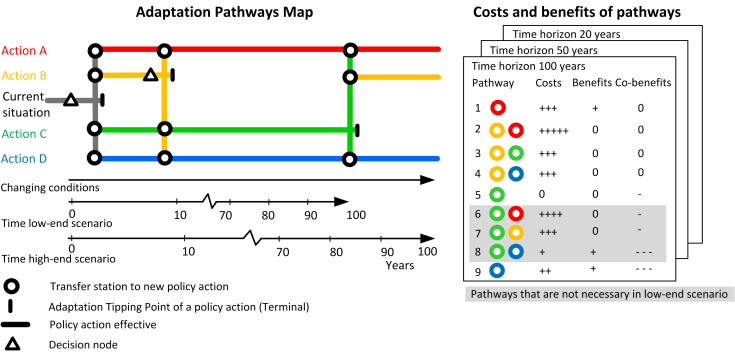Synergies with mitigation and adaptation pathways
Synergies between adaptation and mitigation
Climate mitigation and adaptation respond to the dual challenge of reducing greenhouse gas emissions and adjusting to the inevitable impacts caused by climate change. Despite being traditionally considered separated, there is growing evidence and recognition that mitigation and adaptation should be as much as possible integrated. Identifying synergies can enhance the effectiveness of both and maximize sustainable development and resilience building.
For example, green infrastructure and NBS (i.e., green roofs, permeable pavements) contribute to climate adaptation by reducing heat island effects and supporting better water management, but they also achieve mitigation goals by contributing to carbon sequestration and energy savings. Other sectors where synergies can be realized include land-use, agriculture, water management etc.
The integration of adaptation and mitigation is also a fundamental component of climate resilient development pathways. However, to achieve these synergies, governance structures and policy frameworks should enable this integration. Traditional institutional silos and financial constraints often hinder the successful combination of climate adaptation and mitigation. Within the adaptation policy cycle, it is critical to mainstream adaptation actions across multiple sectorial policies and minimize interventions performed in isolation.
Adaptation pathways for resilience
Climate adaptation planning must confront inevitable uncertainties related to the future and cascading impact of climate change. In particular, when selecting the most suitable adaptation options, it is important to consider different timescale and understand which option is the most effective adaptation solution in a specific place and in a specific time. Furthermore, it is important to minimize “regret”, negative impacts or maladaptation. Robust climate adaptation plans should be adapted over time, leaving some options open in the future and ensuring that actions which apparently seem positive in the near future do not become maladaptation in the long-term.
The Dynamic Adaptive Policy Pathways (DAPP) is a decision support tool that enables to address uncertainties and changing risk, by focusing on thresholds and alternatives options against a range of different scenarios. The DAPP includes a mix of short-term actions and long-term options, enabling flexibility. This approach can be used with stakeholders in participatory processes and enables change to be monitored. In this way, pre-emptive decisions can be made, providing more confidence to decision makers.
DAPP can be used for long-term infrastructure projects, high investment cost decisions or projects where there are several uncertainties about future change and the regret potential is high. In this perspective, the goal of the DAPP is to prioritize “low-regret actions “or “no regret actions”. These actions are cost-effective in the present and under a range of future climate scenarios, and do not involve hard trade-offs with other policy objectives.

Figure 1: Adaptation Pathways Map. Source: Deltares
1. Preparing the ground for adaptation: assemble and organize the essential components to start the adaptation process. It includes gather data and evidence base, secure long-term political commitment for adaption, establish adaptation governance (including the identification of statehooders and engagement plan), assess resources needed and develop a clear communication strategy for all.
2. Assessing climate risk and vulnerabilities: evaluate the climate risks and vulnerability of the considered area. This is done by defining the climate risk assessment principles, methodology and governance; analyse data on climaterelated hazards, exposure and vulnerability; highlight key risks (who and what is at most risk?) By prioritizing most urgent risks, it is possible to determine adaptation priorities and set adaptation objectives.
3. Identify adaptation options: Identifying a range of adaptation measures. This phase includes the creation of a catalogue of adaptation options that are aligned with the identified adaptation priorities and objectives. In this phase, it is also useful to look at good examples of adaptation measures and collect lessons learned.
4. Assessing and selecting adaptation options: Once a set of adaptation options has been identified, a framework with selection criteria should be established to assess the different alternatives and choose which options should be implemented first. The criteria can include aspects such as contribution to sustainability objectives, costs, feasibility, impact on local or regional development, etc.
5. Implement adaptation policies and action: The selected implementation actions can be implemented, either through standalone initiatives or by integrating these into broader plans and strategies. Mainstreaming adaptation into sector policies can enhance this process and increase effectiveness. At the same time, securing funding or financing resources is critical for the successful implementation and this should be done as soon as possible.
6. Monitoring, evaluation and learning (MEL): regularly monitoring and evaluating the effectiveness of adaptation actions (as well as making adjustments where needed) is a critical step to ensure that the adaptation plans are on track and deliver the expected results.
Watch a video about the Dynamic Adaptive Policy Pathways (DAPP) developed by Deltares and TUDelft. This approach has inspired the Adaptive Delta Management Concept of the Dutch Delta Program.
The DAPP can be implemented by municipalities at different levels. The simpler application is an initial qualitative assessment of pathways, and the creation of narrative scenarios based on initial vulnerability assessments; this can be done with engaged stakeholders together with some experts. A second level of application of the DAPP include an initial quantitative study using available information and simple models; this study supports the creation of a quantitative scenario and vulnerability assessment, as well as the definition of adaptation tipping points. Lastly, the full computational assessment of pathways includes the application of specialized decision tools and models.
Stakeholders should participate in all phases of the process and can contribute to different activities, such as participatory problem framing, group model building, scenario visioning, focus group discussion, technical working groups, workshops or advisory groups. Stakeholders should also participate in the monitoring phase and contribute to reassessment or definition of new actions.
Summary
Reflection
1. What are the benefits of mainstreaming climate mitigation and adaptation?
2. What is the added value of adaptation pathways and related tools (such as the DAPP?)
3. Can you explain the concepts of “Tipping Points” in adaptation pathways?




